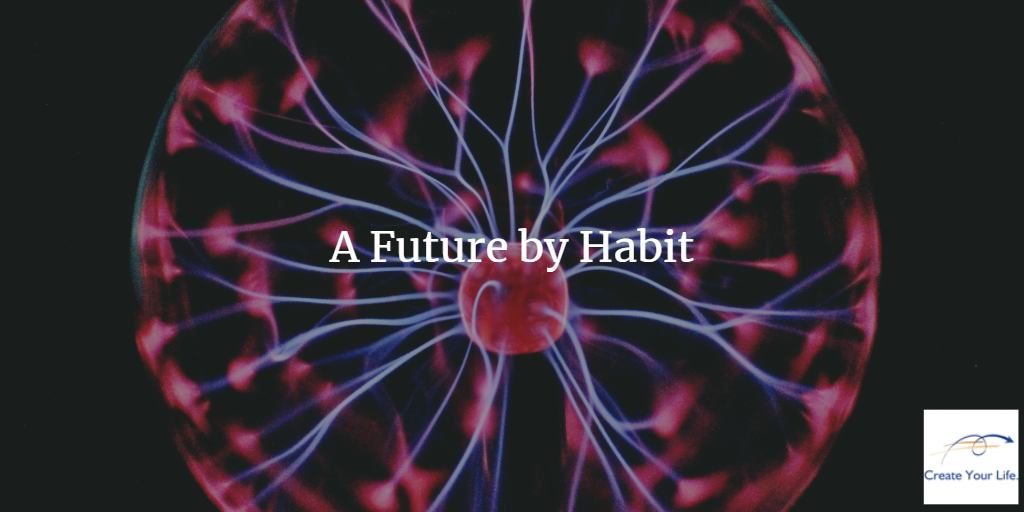We do not decide our future. We decide our habits and our habits decide our future. This is designing a future by habit. We can purposely design that future or we can drift, like a ship without a rudder, not really knowing where we’ll end up. It’s our choice.
“People do not decide their futures, they decide their habits and their habits decide their futures.” ~ F. M. Alexander
Future by Habit
I haven’t always lived my version of an Excelerated Life™. Of course, I only defined what that meant a few years ago, but way before then, my life and my accomplishments were hit and miss. I became really interested in self-development in my mid-30s when I received a copy of Earl Nightingale’s “Lead the Field” on cassette tape. (Yes, it was that long ago.) That led me to such authors and speakers as Brian Tracy, Denis Waitley, Dr. Stephen Covey, Dr. Wayne Dyer, Napoleon Hill, and many others. But most of their ideas and suggestions never took permanent hold with me.
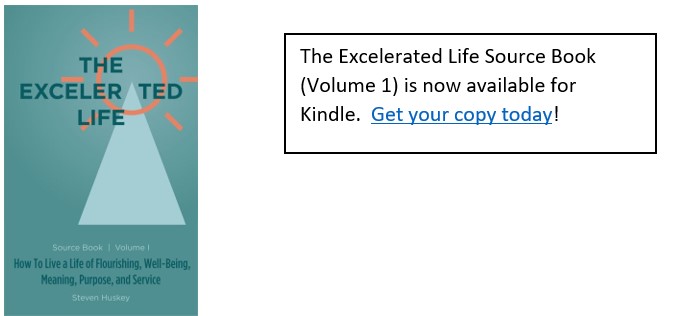
I was a bit like the man Stephen Covey mentioned in The Seven Habits of Highly Effective People. According to Covey, his friend would shine brilliantly for a while, then disappear for weeks and months at a time. He never seemed to be able to make his improvements stick. That pretty much described me for years. My life was on a path like the picture I shared a few months ago.
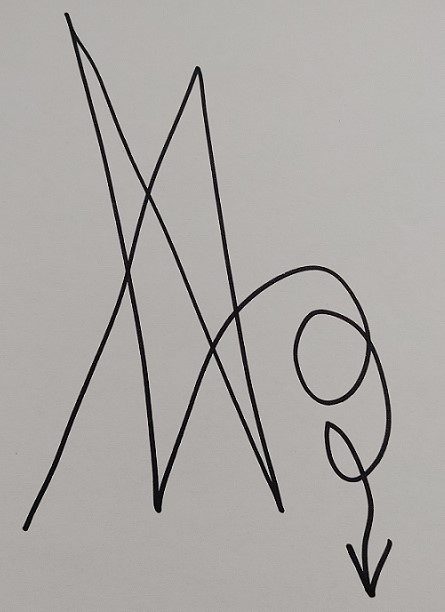
I began my current journaling attempt on Tuesday, January 3, 2017. I knew that I needed to make some changes and on that very first day, I drew this figure:
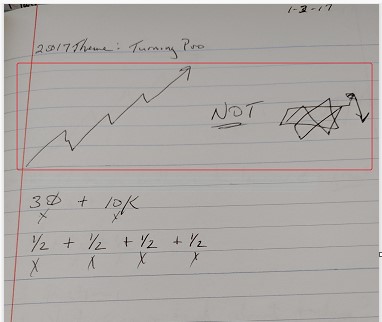
To me, this symbolizes the difference between making slow, steady progress and bouncing all over the board. I knew I needed to make changes to move me from the 2nd figure to the first one. And slowly, deliberately, I did.
Today, six years later, I still draw that illustration, although it has altered slightly over the years.
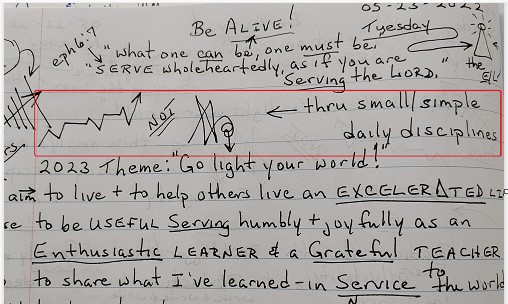
I do it to keep reminding myself of the necessity of making those small, incremental improvements day by day. As I write in my journal, we do this “thru small/simple daily disciplines”.
And I make those small improvements by selecting and installing various habits. You could say that I’m designing my future by habit. I’d like to encourage you to do that, too.
Habits Shape Behavior
“People . . . decide their habits . . .”
It all starts with goals. Our goals are the targets. We must know what we want to do before we can begin building the habits that will help us do it. It’s the difference between starting out on a trip with a specific destination in mind or taking whichever road strikes your fancy. The first option takes you inexorably to your destination but who knows where you’ll end up if you take the second option.
A goal is absolutely necessary to point us in the direction we want to go, but as we begin to form habits, the actual goal becomes less important. “Goals and rewards. . .are critical for starting to do something repeatedly,” writes Wendy Wood, an expert in the field of habit formation. They “lead us to form many beneficial habits in the first place.” [Wood] But after the behavior becomes a habit, the initial reasons we started are no longer important. [Clear]
This is because a strong link is forged between the stimulus (“cue” in habit terminology) and our response (“routine”). We no longer consciously think about the behavior. The habitual behavior is cued up and ready to go. [Wood] We don’t need to rely on discipline anymore to do these behaviors.
Knowing that a large chunk of our future is determined by habit makes it essential that we decide the future we want and select habits that promote our desired future.
Behavior Shapes Life
“. . . and their habits decide their future.”
Habits are basically “reliable solutions to recurring problems in our environment”, solutions that are “easy, compelling, and enjoyable.” [Hreha] As our habits begin to reshape our behavior, we must monitor our progress to be sure we are staying on course. To do this, we can use feedback loops. Feedback loops are the “invisible forces that shape human behavior.” [Clear] It works like this: you try something, you fail, you learn, and you try again.
James Clear identifies three distinct sections of any feedback loop:
- Measure – where are you now?
- Compare – where do you want to go? (Make it personal and relevant.)
- Adjust – what changes do you need to employ?
Decide what you want to create with your life, decide the behaviors that will lead to that future, then establish feedback loops to maximize the behavior. Now you’re building your future by habit. Here are steps to get you started on that now.
Imagine Your Desired Future
You may have heard of “magic wand” thinking. It goes like this: Imagine you have a magic wand. Wave this wand and you can have anything you want. If you had all the time, all the energy, all the money, all the looks, all the resources, all the ________ (you name it) that you’ll ever need, who would you be? What would you do and what would you have?
For this exercise, imagine there are no limits. (You have a magic wand, remember?) Now, list everything that comes to mind.
Decide What Habits Promote Your Desired Future
Look at your list and select the one, the top priority. Of course, before you can do #1 on your list, you may need to do #3, or #5, or #8. Select the first priority or the first step that leads to your #1. Now, turn your magic wand idea into concrete actions that are easy to do for you. These will be the behaviors you seek to make habitual. Select your habits and let your habits determine your future.
Build Algorithms
Once you’ve selected a behavior you want to make habitual, design an algorithm. “An algorithm is a methodical set of steps that can be used to make calculations, resolve problems and reach decisions. An algorithm isn’t a particular calculation, but the method followed when making the calculation.” [Harari]
To help ingrain your habit, set the algorithm up as an Implementation Intention. Peter Gollwitzer, a research psychologist, discovered that a particular type of planning was most effective in creating habits. These plans took the form of “If-Then” statements: “If X occurs then I will do Y.” Gollwitzer called these statements “implementation intentions.” [Gollwitzer] Implementation intentions specify when, where, and how you will take the actions needed to create habits that lead to goal attainment.
Using implementation intentions, you decide in advance how you will perform a particular behavior. This removes the need to deliberate about when and what you will do at the moment the opportunity arises. You are automatically at the starting line. By forming implementation intentions, you switch from conscious and effortful control of behaviors to being prompted automatically by predetermined cues.
Another type of algorithm is BJ Fogg’s “Tiny Habit Recipe”. You can use this to tie your new habit to an existing habit. [Fogg] Here’s how it works.
Make a list of your daily habits: for example, when you get up, in the morning before work, when you get to work, before lunch, after lunch, before you leave work, when you get home, in the evening, before you go to bed.
List some new habits that could naturally follow a few of your existing habits. Pick the ones you like most and write them in the form of a “recipe”: After I ________, then I’ll ________.
Finally, Brian Johnson teaches an entire class on developing and using algorithms. You can access it for free here.
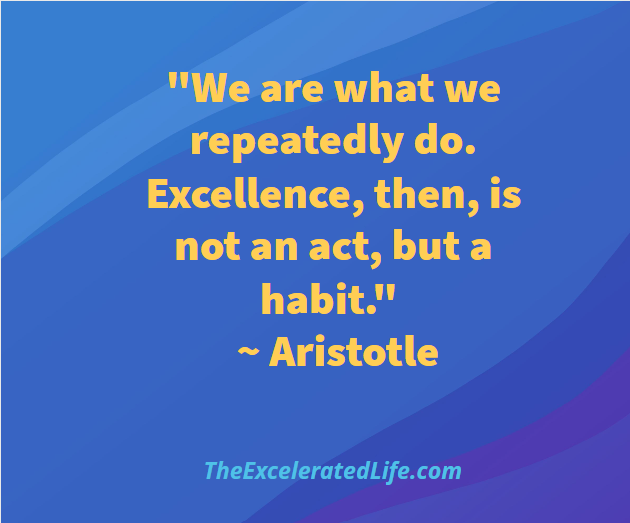
Designing a Habit
For example, suppose you want to learn to play the guitar.
Setting up a feedback loop might look like this:
Measure. Where are you now? Let’s say you are a beginner. You have a new guitar but have not been practicing regularly.
Compare. Where do you want to go? You want to learn how to play your first song.
Adjust. What changes do you need to employ? Find a specific time of day when you can practice. Make it a small step, say 10 minutes (you can always do more). Pick a time when you will practice. Perhaps instead of watching the news on TV, you can practice for the first few minutes of the show.
Now you can design your algorithm as an implementation intention: If it’s time for the news on TV, then I’ll get my guitar and practice for 10 minutes.
After a few days or a week, go through the feedback loop again and make necessary adjustments.
Alternately, you could use Fogg’s habit recipe. Here is what it could look like, as you add a new tiny step each week.
First, decide what habit you will pair your new habit with, for example, eating dinner. Here are some ascending habit recipes:
After I have dinner, I will play 1 chord.
Next week: . . . . I will play 2 chords.
Next week: . . . . I will practice changing chords.
Next week: . . . . I will play 3 chords.
Next week: . . . . I will learn a song with the 3 chords I know.
Turn Ideas Into Action
Decide your future. Remember, if you don’t have a destination in mind, you’ll never get there.
Have a plan. “You have to start with a plan,” says Jeff Olson in The Slight Edge, “but the plan you start with will not be the plan that gets you there.” [Olson] You need a plan – not to get you to the finish line — but to get you to the starting gate. You want a way to start the ball rolling, to tap into the energy of momentum.
Prepare to fail. It’s inevitable if your goals are BIG (Bold-Important-Gratifying). You won’t be able to reach them without learning and one of the best ways to learn is to mess up. But the smaller you make the steps, even especially for your BIG goal, the easier it is to turn a desired behavior into a habit.
So decide–>plan–>do–>fail–>learn–>do better. Repeat. As often as necessary.
Have a Plan II
“The plan you start with is not the plan that gets you there.” Full disclosure here. Some of my habits run like clockwork. For example, I’ve flossed my teeth now over 1300 days in a row. I meditate and do a Sun Salutation every workday morning (but not Sunday or days when we travel). I aspire to have a brief morning workout . . . but that one doesn’t work quite so smoothly. Occasionally I have to step back and make it a smaller step and then work back up to the full routine.
The difference between me now and me years ago is that today I do get back to doing my workout. At one time, missing a day or two would send me into a tailspin, just like the second picture in my journal. Now, a drop along the path is temporary, then I get back on track, like the first drawing.
You can learn to be this way too. You need a plan to get started but you also need a plan to help you keep going and to recover when necessary. In this way, you stay on the upward path, even though you may experience a dip from time to time.
A Future by Habit Reprise
We do not decide our future. We decide our habits and our habits decide our future. This is designing a future by habit. We can purposely design that future or we can drift, like a ship without a rudder, not really knowing where we’ll end up.
It starts with a decision, then using the tools we have learned to turn desired behaviors into habits, using tiny steps to advance, knowing those steps compound over time, so that we eventually cover a great distance.
If you’re on a path that leads in the end to a downward spiral, it isn’t too late to step off that path and onto the one that leads upward, slowly but inevitably. Make the decision to create your future by habit. That’s how you begin to embrace your Excelerated Life™!
What sort of future are your habits leading you toward? Is it one you look forward to?
If so, how could you make those habits stronger? If not, what could you do to get on the upward path?
Share your ideas by leaving a post below.
Excelerated Habits™ — automating your best behaviors — is one step in creating your Excelerated Life™, a life of flourishing and well-being, and a life of meaning, purpose, and service.
Read more about the Excelerated Life™.
Resources:
Clear, James. “How to Master the Invisible Hand That Shapes Our Lives.”
April 29, 2023.
https://jamesclear.com/feedback-loops
Covey, Stephen R. The Seven Habits Of Highly Effective People. New York: Simon & Schuster, 1989.
Fogg, Ph.D., BJ. Tiny Habits: The Small Changes That Change Everything. New York: Houghton Mifflin Harcourt Publishing Company, 2020.
Gollwitzer, Peter M. and John A. Bargh. Psychology of Action: Linking Cognition and Motivation to Behavior. New York: The Guilford Press, 1996.
Harari, Yuval N. Homo Deus: A Brief History of Tomorrow. London: Vintage, 2016.
Hreha, Jason. “What Is A Habit?” thebehavioralscientist.com. Jason Hreha, . Web. May 12, 2023
https://www.thebehavioralscientist.com/articles/what-is-a-habit
Olson, Jeff. The Slight Edge. Austin, TX: Greenleaf Book Group Press, 2005-2013.
Wood, Wendy. Good Habits, Bad Habits. New York: Farrar, Straus and Giroux, 2019.


